

Today I wanted to look at the history of another of London’s great Royal Palaces – Hampton Court.
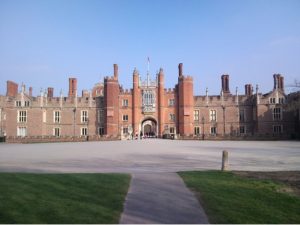
As you can guess there is a lot to tell and I could not decide what to choose so I decided to do something a little different and give you an overview with not only well-known facts but maybe lesser-known ones in the form of an A-Z. Maybe you will learn something new or it may encourage you to visit.
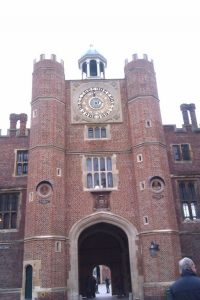
When entering Hampton Court Palace through Clock Court one cannot help but notice the beautiful clock sitting up to the gatehouse. This clock was designed by Nicholas Kratzer and built by Nicholas Oursian in 1540. Not only does it tell the time but the phases of the moon, signs of the zodiac, the suns movement and the time of high tide at London Bridge.
Hampton Court Palace is a tale of two Palaces – at the front, the visitor is met with the magnificent Tudor red-bricked frontage from the time of Henry VIII. At the back and what greets the visitor, approaching from the Gardens is the impressive classical Baroque Palace from the time of William and Mary.
They originally had plans to knock down the whole Palace and rebuild it in the Baroque style with the help of Sir Christopher Wren. However, due to costs, only parts of the old Tudor Palace were destroyed and paved the way for the modern.
Baroque was a style, which became popular across all of Europe and England in the 17th Century. It took the classical designs but recalibrated it to create a sense of drama to the buildings. It was a grand elaboration of detail and space. It also used the orders of pilasters to unify storeys.
Possible one of my favourite places at the Palace the Chapel Royal is a beautiful place. Built at the request of Henry VIII in his improvements to the Palace one cannot help but look up in awe at the vaulted ceiling, which was completed in the 1530s.
The Chapel stayed pretty much the same until Christopher Wren remodelled it at the request of Queen Anne in 1710.
Up above the main body of the Chapel is a single room like a box at the Theatre. This would have been where the royal family would sit when worshipping. Today there is a replica of the Crown worn by Henry VIII while at the Palace. It was here that Henry received a letter from Archbishop Cranmer outlining accusations of adultery by Catherine Howard.
Lord Daubeney was a great supporter of Henry VIII and acquired the manor of Hampton Court from the Knights Hospitaller in 1494. He fought on the Battlefield of Bosworth and was the Lord Chamberlain of Henry VII household. He enlarged and improved the Manor at Hampton court including adding the great kitchen. He made it grand enough to entertain royalty of who visited several times. It was after his death that his son would sell Hampton Court onto Cardinal Wolsey.
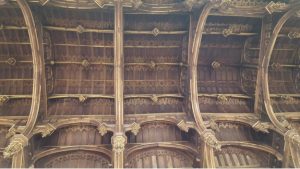
Another great sight at the Palace would have to be its great hall. Today it is considered one of the greatest medieval halls of England. It measures 108 feet by 40 feet and rises 60 feet in height.
Its decor consist of the walls being hung with great tapestries telling the story of Abraham, the light comes from the stained glass windows and at one end a raised dais where the king would have feasted.
What is its most beautiful feature is the hammer-beam roof. Decorating the hammer-beam roof is several shields of those who were important to the Tudor Court; in 1536, this would have included the wooden initials of HA representing Henry and Anne Boleyn. With her fall from favour, all traces of her were removed but one it seems was forgotten and can be found on the ceiling in the great hall. Also in the ceiling are carvings of Eavesdroppers. These would have been placed around the ceiling of the great hall to remind all that nothing stays a secret and someone is always listening.
The final royal to use the Palace would be King George II who in 1737 decided he no longer wanted to use it. Many of the rooms at the Palace would be put to new use and became and favour apartments.
This meant that the property is owned by the monarch but leases it free to a person of their choosing, usually as gratitude for services rendered. At this time, those living in the apartments were aristocratic widows whose husbands had given service to the King. The Grace and favour apartments at Hampton court continued with the last being granted in the 1960s.
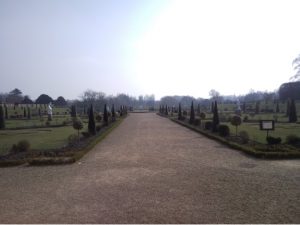
Hampton Court Palace is surrounded by 60 acres of beautiful gardens. With each new royal family and change to the Palace came new designs to the gardens also. Most of these gardens still survive today. There is William and Marys Great Fountain Garden to complete their new baroque palace. It has 13 fountains and two avenues of Yew Trees. There is also the Privy Garden first designed as Henry VIII heraldic garden and today a 1995 reconstruction of William III 1701 formal Privy Garden, which is met by the magnificent Tijo Screen designed by Jean Tijou in 1690.
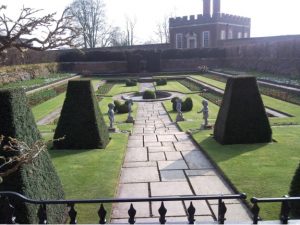
The Wilderness garden began as an orchard until it was modernised by Charles ii mistress Lady Castlemaine. Inspired by the Italian grove or Bosco, it was an area of interwoven trees and paths to create outdoor ‘rooms’. It is also, where the maze is located and my favourite of all the gardens.
Historic Royal Palaces are the charitable organisation who run and manage Hampton Court today. They took over management of not only Hampton Court but also of Kew Palace, the Tower of London, Kensington Palace State Apartments, and the Banqueting House. They took over from the Department of the Environment in 1989.
Imprisonment does not come to mind when you visit Hampton Court but in fact, it was a ‘prison’ for two royal monarchs who both would be beheaded for their crimes. The first was Catherine Howard, Henry VIII fifth wife who would be confined to her apartments at Hampton Court when Henry was made aware of her misconduct as his wife. The story goes that she managed to escape her guards and ran towards Henry in the Chapel through the Long Gallery but before he could hear her pleas and cries, she was dragged back to her suite of rooms. Today this gallery is said to be haunted by her spirit.
The Second Monarch to be held at here was King Charles I. He was taken there in 1647 and although he was a prisoner, he was allowed to still lead a comfortable and elegant life at the Palace where he would have visits from his children who he was overjoyed to see. Even Cromwell visited him whilst he was imprisoned here. Cromwell soon learnt his mistake of allowing the King such lapsed imprisonment as Charles would escape one evening in October and would not be recaptured for another two years. This time however he was not taken to Hampton Court but kept in a more secure setup and would eventually be executed outside the Banqueting House in 1649.
In January 1605, a great conference was held at Hampton Court Palace that would impact the way the Bible is read. This conference, chaired by King James I was to lead to the authorised translation of the Bible into English, which would be known as the King James Bible. Both Puritans and members of the Church of England represented the conference.
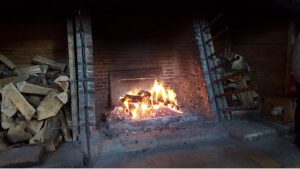
Another great survival of the Tudor Palace it is Kitchens. The ones at Hampton Court were the largest in Tudor England and would produce 800 meals a day for Henry’s household. They would be in use for another 200 years and were an essential part of the daily running of the Palace. Go and visit the kitchens yourself and feel the warmth of the great fire.
The Palaces of King Louis XIV of France, the Sun King, heavily influenced much of the Stuart developments at Hampton Court Palace and its design. The layout and design of his Palace of Versailles were used to create the Cartoon Gallery and other areas. William and Marys new apartments were based on the designs used at the Louvre, in Paris.
Also, it was not just designed but how ceremony and tradition which the English monarchs looked to the Sun King for. Our monarchs adopted his ceremony of dressing and undressing.
The maze, which was originally one of three, is the UK’s oldest surviving hedge maze. It is believed that it was commissioned by William III and designed by George London and Henry Wise. It covers a third of an acre and is located in the Wilderness Garden. How long will it take you to find the exit?
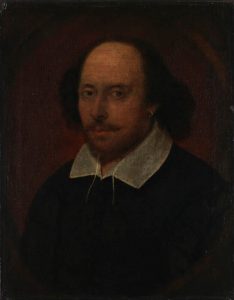
King James would spend Christmas and New Year of 1604-5 at Hampton Court. Included in the festivities would be a performance of a Midsummer’s Nights Dream (my favourite Shakespeare play) in the Great Hall by the Kings Men whose dramatist was none other than William Shakespeare.
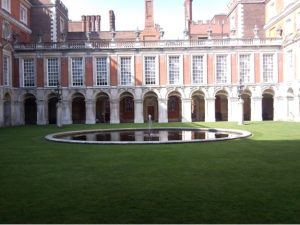
Hampton Court Palace has been the location of many blockbuster movies and TV shows, the most recent being scenes from The Favourite starring Olivia Coleman and about Queen Anne and Lady Marlborough. Scenes were shot in the Great Kitchens, The Serving Place, Cartoon Gallery and Fountain Court (pictured).
Other films include Sherlock Holmes: A Game of Shadows (2011), Pirates of the Caribbean: On Stranger Tides (2011), The New World (2005)The Young Victoria (2009) and The Libertine (2004) to name a few. TV shows, as well as documentaries, include Little Dorrit (2008), John Adams (2008), and The Six Wives of Henry VIII (2001).
All the proceeds made from filming at the Palaces goes back into the conservation of the Palace.
Sybil Penn was the dry nurse to King Edward VI and a woman of the Bedchamber to Queen Elizabeth I. It was while at Hampton Court Palace that Elizabeth came down with Smallpox so severely that the Drs thought she would not survive. Penn would nurse Elizabeth day and night to help her sovereign recover back to health, which Elizabeth did. Unfortunately, Penn did not and succumbed to the disease. It is said that she is one of the ghosts at the Palace and sightings only started when her grave was disturbed at the parish church. She is believed to be a grey spectre wandering Clock Court and responsible for working a spinning wheel in a room where there is nothing there.
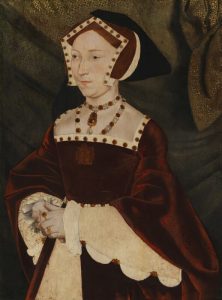
Several English Queens have lived at Hampton Court and experienced times of sorrow and joy in its walls. It was one of the final places visited by Elizabeth of York before she died after childbirth complications at the Tower of London in 1503. The Palace underwent some changes to make way for Anne Boleyn in 1536 but as soon as she fell from grace all reminders of her were removed. Her successor, Jane Seymour would die at the Palace in 1537 after giving birth to Edward. Her rooms no longer exist today but her ghosts are said to haunt the Silverstick staircase. Her heart is buried in the Chapel. I have already spoken about Catherine Howard at the Palace.
Queen Mary I would take her confinement at the Palace when she was convinced she was pregnant in April 1555. Unfortunately, it turned out to be a phantom pregnancy and eventually her husband King Philip of Spain spent more and more time away from her.
Queen Mary, the granddaughter of King Charles I and her husband William of Orange would work in partnership in the redesigning of Hampton Court into its Baroque splendour. Sir Christopher Wren found in her a keen and willing patron to create the longed-for Palace, which he had wanted to; build (even though the plans were scaled down). She was the drive behind the changes to the palace and would have detailed discussion with Wren about how to proceed due to her husband being in French campaigning. On her death, plans came to a standstill at the Palace or a time.
Mary’s sister, Queen Anne spent the last four years of her life at Hampton Court making vast improvements including the Chapel Royal, which we see today. In her reign, she would use the Palace as a midway point from London and her country retreat of Windsor and when in residence the Palace became the site of political intrigue and factions.
Tennis or real Tennis (a tag added at the end of the 19th century to separate it from ‘lawn tennis’ was a popular sport in the Tudor Period and Henry VIII enjoyed playing it in his younger days. Wolsey had a tennis court built at Hampton Court Palace between 1526 – 1529. The current one dates from 1625.
The Real Tennis Champions Trophy takes place at Hampton Court Palace every summer, supported by Mitsubishi Electric.
The Cardinal Spider is said to have its name from Cardinal Wolsey’s fear of them. They were a common sight around the Palace, and can grow quite large!
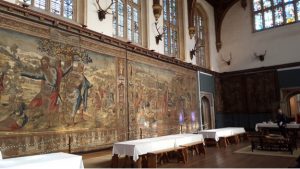
In the Great Hall at Hampton, one cannot miss the magnificent Tapestries hung on its walls. In the Tudor period, tapestries were a sign of wealth and status.
These Tapestries are a series of 10 panels most likely commissioned by Henry VIII and show scenes from the life of Abraham from the Book of Genesis. Completed in 1546, they were woven in Brussels from wool, silk and thread of Gold and Silver. They would have been a bright burst of colour (unfortunately, the colour has faded over time).
After King Charles I execution in 1649 they were valued at £8,260 and would have been the most valuable item in the late king’s collection. They are considered one of the finest pieces of decorative artwork from the period.
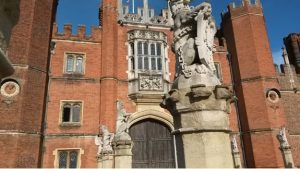
Yes, there are Unicorns as well as Dragons at Hampton Court Palace, although only pretend ones. The unicorns can be spotted outside the main gatehouse as one enters the Palace. It is part of eight carved beasts, known as the Kings Beasts, which were originally installed at the request of King Henry VIII. Each carving represents the ancestry of either Henry or his third wife Jane Seymour. There is the Lion of England, the Royal Dragon, the Black Bull of Clarence, the Yale of Beaufort, the white lion of Mortimer, the White Greyhound of Richmond, the Tudor Dragon, the Seymour Panther, and the Seymour Unicorn.
Heading towards William III State Apartments, one cannot miss the beautiful painting on the staircase titled ‘Victory of Alexander over the Caesars. Italian artist Antonio Verrio painted it. Verrio would work for the English monarchy for 30 years and earned himself lodgings and a pension at Hampton Court where he died in 1707.
The 12 Caesars represents the Catholic forces that William has ousted in the Glorious Revolution. William is the hero, Alexander.
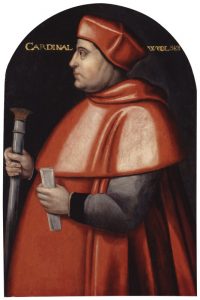
Cardinal Wolsey was the Chief Minister of King Henry VIII and was the last of his type to be seen in England. The son of a Butcher Wolsey worked his way up to be King in all but name. As a result, he, therefore, needed to live like one and would inherit several luxurious sites which came with his various titles which he improved, making them fit for a King. Hampton Court he would acquire privately of Lord Daubeney and was to be his country retreat to entertain.
His developments to the Palace which we can see today is the spectacular entrance, Base Court, the along Gallery and his suite of rooms with their ribbed ceilings which is still there today. Wolsey would also add a suite of rooms for not only the King but also his wife and eldest daughter Princess Mary.
Many would say Wolsey’s downfall was a result of him getting too greedy and living better than the king himself. Wolsey, however, would say that as he represented the King he, therefore, needed to live like him so he could do Henry justice. He even allowed Henry the use of all his homes to use at his leisure.
Wolsey’s downfall was mainly due to the fact of not being able to get a resolution the Kings Great Matter – his divorce from Catherine of Aragon. He fell, and he fell hard. He would eventually die on way to the Tower of London to face trial in 1503
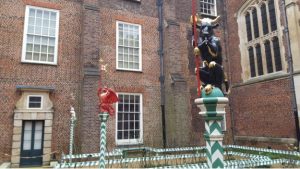
In Chapel Court, there is a beautiful garden, which was created to mark the 500th anniversary of Henry VIIIs ascension to the throne. The insertion for the garden came from the Family of Henry viii portrait, which shows Henry with all three children and his third wife Jane Seymour. Although the setting for the painting is from Whitehall Palace, there is a garden in the background, which would have been similar to those at Hampton Court.
Some of the plants included in the garden are Irises, Periwinkle, Miny, Gilly Flower, the Red rose (of Lancaster) and the White Rose of York (Rosa x alba). Henry VIII’s parents being from each of the Houses and supposedly uniting the warring houses in what was termed by Shakespeare the Wars of the Roses.
William III apartments show what life would have been like a Court for a courtier who wanted an audience with the King. Each room from the Guard Chamber to the Bedroom each gets more lavish in style and each room the closer one got to the monarch.
The first room to get through would have been the guard chamber and one would have been met with the yeoman of the Guard. They would make sure that couriers were suitably dressed and well behaved before allowing them to progress further.
Next, they would enter the Presence Chamber, the official throne room followed by the Privy Chamber where on statement and courtiers who were close to the king would have been permitted. The Great Bedchamber was where one could watch the king’s ceremony of dressing in the morning; he slept in the room next door – the Little Bedroom.
Hampton Court Palace lies in Zone 6 of the London Underground. It takes 50 minutes from Waterloo to get there by train and once you arrive you cannot but be in awe of the great Palace. It sits right onto of the River (and sometimes you can even take a boat ride there instead and be like the nobility of old).
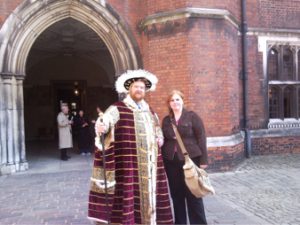
My name is Laura and I am fascinated and interested in the past. Ever since secondary school, I have had an interest in history. I think this was down to having such an amazing history teacher who made it fun and fascinating. He taught me that it was not all boring and academic – that we can explore, question and visit the sites where our ancestors have been – that history is not one set story but a mixture of stories and as historians, we have to sift through it all to identify the truth.
I try to visit as many historic sites as I can and to delve into the history of my local area of Shoeburyness and Southend. From doing this I have come to realise that one does not need to have had a battlefield or castle in one’s garden to enjoy history. It is everywhere – even down to the street and town names. They all have their origins in our past.
I have worked for the amazing charity Historic Royal Palaces and have been fortunate to work at such locations as the Tower of London and the Banqueting House. I have given talks and tours on London and Tudor History and am an amateur Ripperologist.
Website: www.fortheloveofhistory.home.blog
Instagram: @fortheloveofhistory.blog
Facebook: @fortheloveofhistory.blog
Twitter: @lovehistoryblog
If you want to find out more about other royal Palaces in London check out my Martin, Murder and Myths – stories from the Tower of London